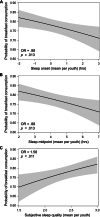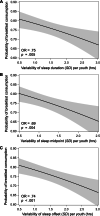Worse sleep health predicts less frequent breakfast consumption among adolescents in a micro-longitudinal analysis
- PMID: 35715858
- PMCID: PMC9205101
- DOI: 10.1186/s12966-022-01265-5
Worse sleep health predicts less frequent breakfast consumption among adolescents in a micro-longitudinal analysis
Abstract
Background: Poor self-reported sleep health has been linked to not consuming breakfast in adolescents, but it is unknown whether poor sleep measured objectively predicts next-day breakfast consumption within adolescents. We investigated within- and between-person associations of objectively measured sleep dimensions and subjective sleep quality with adolescent breakfast consumption.
Methods: Data were collected from a micro-longitudinal substudy of the Year 15 wave of the Fragile Families and Child Wellbeing Study (n = 590). Adolescents wore an actigraphy device and completed daily diaries for ~ 1 week (M ± SD = 5.6 ± 1.4 nights per adolescent, range: 3-9), where they rated their sleep quality and reported whether they had eaten breakfast that day, with no specific definition of breakfast provided (M ± SD = 5.5 ± 1.4 days per adolescent, range: 3-9). Separate mixed models assessed whether actigraphy-measured sleep duration (linear and quadratic, sleep duration x sleep duration), timing, maintenance efficiency, and subjective quality predicted odds of breakfast consumption both within and between adolescents. Variability of sleep duration and timing (standard deviation per person), sleep regularity index (SRI), and social jetlag were tested as additional between-person predictors. Analyses with predictors other than sleep duration were adjusted for sleep duration.
Results: Following nights when adolescents had shorter or longer sleep duration (p = .005; curvilinear association), later sleep onset, or later sleep midpoint (both p = .025) than their own usual, they had lower odds of consuming breakfast the next day (within-person associations). Adolescents who on average had later sleep onset (p = .013) or midpoint (p = .013) or who reported lower sleep quality (p = .011) had lower average odds of consuming breakfast (between-person associations). Adolescents with greater variability of sleep duration (p = .005), midpoint (p = .004), or offset (p < .001) had lower average odds of consuming breakfast (between-person associations). Sleep maintenance efficiency (within or between adolescents), SRI, and social jetlag were not associated with breakfast consumption (all p > .10).
Conclusions: Multiple dimensions of sleep health are associated with breakfast consumption, both within and between adolescents. Poor sleep and dietary behaviors in adolescence may negatively impact future metabolic health.
Keywords: Actigraphy; Adolescence; Breakfast; Diary; Sleep duration; Sleep maintenance efficiency; Sleep timing; Sleep variability; Social jetlag; Subjective sleep quality.
© 2022. The Author(s).
Conflict of interest statement
None of the authors have conflicts of interests related to the material presented. Outside of the current work, OMB received subcontract grants to Pennsylvania State University from Proactive Life (formerly Mobile Sleep Technologies) doing business as SleepSpace (National Science Foundation grant #1622766 and National Institutes of Health/National Institute on Aging Small Business Innovation Research Program R43AG056250, R44 AG056250), honoraria/travel support for lectures from Boston University, Boston College, Tufts School of Dental Medicine, Harvard Chan School of Public Health, New York University, and Allstate, consulting fees from Sleep Number, and an honorarium for his role as the Editor-in-Chief of Sleep Health (sleephealthjournal.org).
Figures



Similar articles
-
Sleep variability and regularity as contributors to obesity and cardiometabolic health in adolescence.Obesity (Silver Spring). 2023 Mar;31(3):597-614. doi: 10.1002/oby.23667. Epub 2023 Feb 8. Obesity (Silver Spring). 2023. PMID: 36754840 Free PMC article. Review.
-
Too Jittery to Sleep? Temporal Associations of Actigraphic Sleep and Caffeine in Adolescents.Nutrients. 2021 Dec 23;14(1):31. doi: 10.3390/nu14010031. Nutrients. 2021. PMID: 35010906 Free PMC article.
-
Actigraphic Sleep Variability is Associated With Lower Positive Mood in Adolescents.J Adolesc Health. 2023 Sep;73(3):478-485. doi: 10.1016/j.jadohealth.2023.04.019. Epub 2023 Jul 6. J Adolesc Health. 2023. PMID: 37410005 Free PMC article.
-
Why so slangry (sleepy and angry)? Shorter sleep duration and lower sleep efficiency predict worse next-day mood in adolescents.J Adolesc. 2023 Aug;95(6):1140-1151. doi: 10.1002/jad.12182. Epub 2023 May 3. J Adolesc. 2023. PMID: 37138384 Free PMC article.
-
Association of Physical Activity and/or Diet with Sleep Quality and Duration in Adolescents: A Scoping Review.Nutrients. 2024 Oct 1;16(19):3345. doi: 10.3390/nu16193345. Nutrients. 2024. PMID: 39408312 Free PMC article.
Cited by
-
Influence of study shift on the interrelationships among chronobiological factors, health practices, and anthropometry in adolescents.PLoS One. 2025 May 30;20(5):e0322617. doi: 10.1371/journal.pone.0322617. eCollection 2025. PLoS One. 2025. PMID: 40446011 Free PMC article.
-
Sleep variability and regularity as contributors to obesity and cardiometabolic health in adolescence.Obesity (Silver Spring). 2023 Mar;31(3):597-614. doi: 10.1002/oby.23667. Epub 2023 Feb 8. Obesity (Silver Spring). 2023. PMID: 36754840 Free PMC article. Review.
-
Breakfast Skipping and Associated Factors Among Jordanian University Students.Iran J Nurs Midwifery Res. 2024 Jan 9;29(1):125-132. doi: 10.4103/ijnmr.ijnmr_301_22. eCollection 2024 Jan-Feb. Iran J Nurs Midwifery Res. 2024. PMID: 38333350 Free PMC article.
-
Association between sleep duration and long-term changes in novel anthropometric and atherogenic indices: a cohort study.BMC Public Health. 2025 May 1;25(1):1611. doi: 10.1186/s12889-025-22868-0. BMC Public Health. 2025. PMID: 40312712 Free PMC article.
-
Sleep status and its association with dietary habits among children and adolescents in Shandong Province, China: a cross-sectional study.BMC Public Health. 2025 Mar 25;25(1):1142. doi: 10.1186/s12889-025-22412-0. BMC Public Health. 2025. PMID: 40133972 Free PMC article.
References
-
- Ardeshirlarijani E, Namazi N, Jabbari M, Zeinali M, Gerami H, Jalili RB, et al. The link between breakfast skipping and overweight/obesity in children and adolescents: a meta-analysis of observational studies. J Diabetes Metab Disord. 2019;18:657–664. doi: 10.1007/s40200-019-00446-7. - DOI - PMC - PubMed
-
- Kim HYP, Frongillo EA, Han SS, Oh SY, Kim WK, Jang YA, et al. Academic performance of Korean children is associated with dietary behaviours and physical status. Asia Pac J Clin Nutr. 2003;12:186–192. - PubMed
Publication types
MeSH terms
Grants and funding
- R01HD39135/eunice kennedy shriver national institute of child health and human development
- R01HD073352/eunice kennedy shriver national institute of child health and human development
- T32 DA017629/DA/NIDA NIH HHS/United States
- R01HD36916/eunice kennedy shriver national institute of child health and human development
- R01HD40421/eunice kennedy shriver national institute of child health and human development
LinkOut - more resources
Full Text Sources

